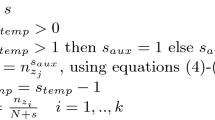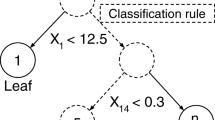Abstract
The random forests (RF) algorithm, which combines the predictions from an ensemble of random trees, has achieved significant improvements in terms of classification accuracy. In many real-world applications, however, ranking is often required in order to make optimal decisions. Thus, we focus our attention on the ranking performance of RF in this paper. Our experimental results based on the entire 36 UC Irvine Machine Learning Repository (UCI) data sets published on the main website of Weka platform show that RF doesn’t perform well in ranking, and is even about the same as a single C4.4 tree. This fact raises the question of whether several improvements to RF can scale up its ranking performance. To answer this question, we single out an improved random forests (IRF) algorithm. Instead of the information gain measure and the maximum-likelihood estimate, the average gain measure and the similarity-weighted estimate are used in IRF. Our experiments show that IRF significantly outperforms all the other algorithms used to compare in terms of ranking while maintains the high classification accuracy characterizing RF.
Similar content being viewed by others
References
Provost F, Domingos P. Tree induction for probability-based ranking. Machine Learning, 2003, 52(3): 199–215
Ling C X, Yan R J. Decision tree with better ranking. In: Proceedings of 20th International Conference on Machine Learning. 2003, 480–487
Jiang L X, Li C Q, Cai Z H. Learning decision tree for ranking. Knowledge and Information Systems, 2009, 20(1): 123–135
Jiang L X, Wang D H, Zhang H, Cai Z H, Huang B. Using instance cloning to improve naive Bayes for ranking. International Journal of Pattern Recognition and Artificial Intelligence, 2008, 22(6): 1121–1140
Bradley A P. The use of the area under the roc curve in the evaluation of machine learning algorithms. Pattern Recognition, 1997, 30(7): 1145–1159
Hand D J, Till R J. A simple generalisation of the area under the roc curve for multiple class classification problems. Machine Learning, 2001, 45(2): 171–186
Ling C X, Huang J, Zhang H. Auc: a statistically consistent and more discriminating measure than accuracy. In: Proceedings of 18th International Joint Conference on Artificial Intelligence. 2003, 519–526
Quinlan J R. C4.5: Programs for Machine Learning. San Francisco: Morgan Kaufmann, 1992
Mitchell T M. Machine Learning. New York: McGraw-Hill, 1997
Breiman L. Random forests. Machine Learning, 2001, 45(1): 5–32
Dietterich T G. An experimental comparison of three methods for constructing ensembles of decision trees: Bagging, boosting and randomization. Machine Learning, 2000, 40(2): 139–157
Breiman L. Bagging Predictors. Machine Learning, 1996, 24(2): 123–140
Bauer E, Kohavi R. An empirical comparison of voting classification algorithms: bagging, boosting and variants. Machine Learning, 1999, 36(1–2): 105–139
Witten I H, Frank E. Data Mining: Practical Machine Learning Tools and Techniques. 2nd ed. San Francisco: Morgan Kaufmann, 2005
Quinlan J R. Induction of decision trees. Machine Learning, 1986, 1(1): 81–106
Wang D H, Jiang L X. An improved attribute selection measure for decision tree induction. In: Proceedings of 4th International Conference on Fuzzy Systems and Knowledge Discovery. 2007, 654–658
De Mántaras R L. A distance-based attribute selection measure for decision tree induction. Machine Learning, 1991, 6(1): 81–92
Pazzani M J, Merz C J, Murphy P M, Ali K. Hume T, Brunk C. Reducing misclassification costs. In: Proceedings of 11th International Conference on Machine Learning. 1994, 217–225
Bradford J P, Kunz C, Kohavi R, Brunk C, Brodley C E. Pruning decision trees with misclassification costs. In: Proceedings of 10th European Conference on Machine Learning. 1998, 131–136
Provost F J, Fawcett T, Kohavi R. The case against accuracy estimation for comparing induction algorithms. In: Proceedings of 15th International Conference on Machine Learning. 1998, 445–453
Jiang L X, Wang D H, Cai Z H. Scaling up the accuracy of bayesian network classifiers by m-estimate. In: Proceedings of 3rd International Conference on Intelligent Computing. 2007, 475–484
Smyth P, Gray A, Fayyad UM. Retrofitting decision tree classifiers using kernel density estimation. In: Proceedings of 12th International Conference on Machine Learning. 1995, 506–514
Nadeau C, Bengio Y. Inference for the generalization error. Machine Learning, 2003, 52(3): 239–281
Author information
Authors and Affiliations
Corresponding author
Rights and permissions
About this article
Cite this article
Jiang, L. Learning random forests for ranking. Front. Comput. Sci. China 5, 79–86 (2011). https://doi.org/10.1007/s11704-010-0388-5
Received:
Accepted:
Published:
Issue Date:
DOI: https://doi.org/10.1007/s11704-010-0388-5




